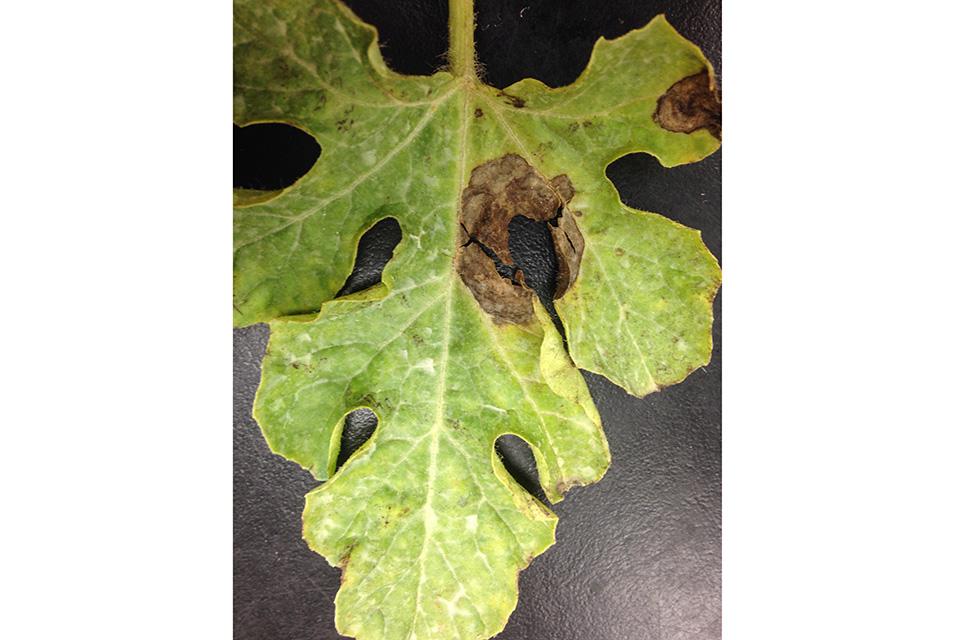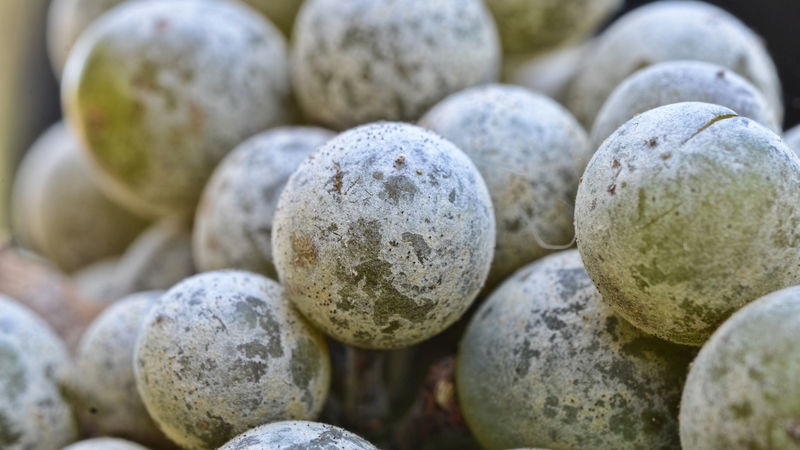Recognize and Manage Fungicide Resistance in Your Vegetable Plantings

The fungus that causes gummy stem blight on watermelon is resistant to four fungicides used on watermelon.
Photo by Anthony Keinath
In 1996, the Food Quality Protection Act (FQPA) promoted registration of reduced-risk fungicides that home in on a single target in the pathogen. Twenty-five years later, it’s clear these site-specific pesticides increase problems with fungicide resistance. As of 2019, the Fungicide Resistance Action Committee (FRAC) counted 123 fungi and water molds (oomycetes) resistant to one or more fungicides.
Older fungicides that were re-registered under the FQPA, like mancozeb and chlorothalonil, are called multi-site fungicides with FRAC Code M for “multi-site.” As these chemicals attack fungi and water molds, they interfere with several different essential physiological processes. It’s harder to find a fungus with two or more mutations that make it resistant to multi-site fungicides than a fungus with one mutation that makes it resistant to a reduced-risk fungicide.
Two diseases of local importance in the Southeast are gray mold on strawberry and gummy stem blight on watermelon. Both fungi that cause these diseases are on the FRAC “most wanted” list of pathogens at high risk of becoming resistant to multiple fungicides. Gray mold is resistant to fungicides in seven FRAC Codes (1, 2, 7, 9, 11, 12, and 17), and the gummy stem blight fungus is resistant to four (1, 3, 7, and 11).
In both cases, many isolates (individuals) are resistant to four or five fungicides, like multiple-drug resistance in the human pathogens that cause tuberculosis or gonorrhea. An analysis of probability with 214 isolates of gray mold yielded the following likely path to multiple resistance. Resistance to FRAC 1 developed first, since thiophanate methyl (Topsin) is the oldest fungicide in the list of resistances, followed in order by resistance to FRAC 11, 7, 9, and finally 17.
Risky Business
Often there is a familiar pattern of “fungicide abuse” in cases of fungicide resistance. Consider these real-life scenarios based on how resistance to Quadris (FRAC 11) developed in the gummy stem blight fungus.
A grower wants to save money and sprays half the recommended rate of a fungicide. A few individuals tolerate the lower dose and survive.
A neighbor sprays a FRAC 11 fungicide three times in a row, even though the label reads, “rotate after every application.” Repeated exposure selects for resistant individuals.
Transplant growers spray a FRAC 11 fungicide in the greenhouse despite the prohibition on the label. In a closed environment, exposing the individuals multiple times.
Agrochemical companies sell premix fungicides for several reasons, including formulating products effective against a wider range of common diseases than each fungicide by itself. Premixes also reduce the risk of fungicide resistance, because it’s less likely for a fungus to survive a dose of both fungicides. Unfortunately, some currently available premixes are poor pairings of active ingredients for resistance management.
Growers still sprayed Pristine (Cabrio plus Endura, FRAC 11+7) (BASF) to combat gummy stem blight after resistance to FRAC 11 appeared, because the FRAC 7 half still worked. Without an effective “wingman,” resistance to Endura appeared several years after resistance to FRAC 11.
Luna Sensation, which is Flint (FRAC 11) plus Luna (both BayerCrop Science) — a different FRAC 7 active than the Endura in Pristine — is also at risk because of FRAC 11 resistance. It should be used sparingly against gummy stem blight on cucurbits.
Orondis Ultra is a mixture of Orondis (FRAC 49) and Revus (both Syngenta) (FRAC 40).
The cucumber strain of downy mildew is resistant to Revus, so if Orondis Ultra is sprayed on cucumber, it’s as if straight Orondis is sprayed.
Proactive Management
Several proven strategies reduce the risk of fungicide resistance. These proactive methods are part of good fungicide stewardship and being a good neighbor, since resistant strains can spread by air to other farms, counties, and states.
The general principle is to increase the number of FRAC Codes used in a spray program.
Switch from an at-risk product to another effective fungicide in a different FRAC Code.
Alternate your go-to fungicide with a fungicide with a different FRAC Code.
Tank mix your favorite fungicide with a multi-site protectant (FRAC Code M). An old-fashioned contact fungicide, like chlorothalonil or mancozeb, usually is cheaper than tank-mixing with a newer fungicide (if the protectant is registered on the crop).
A good fungicide is like a sharp knife — use it carefully.










